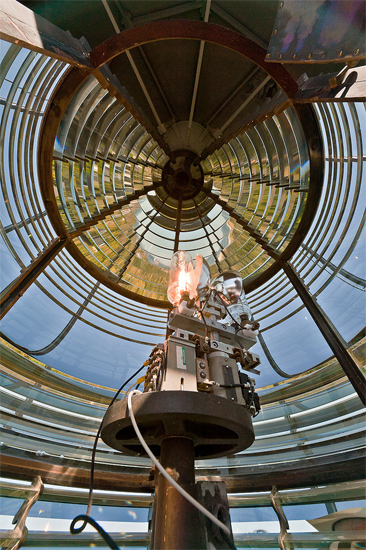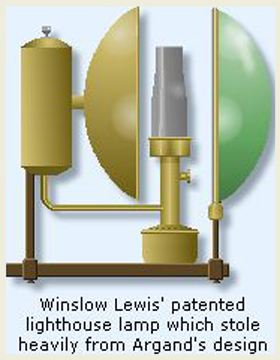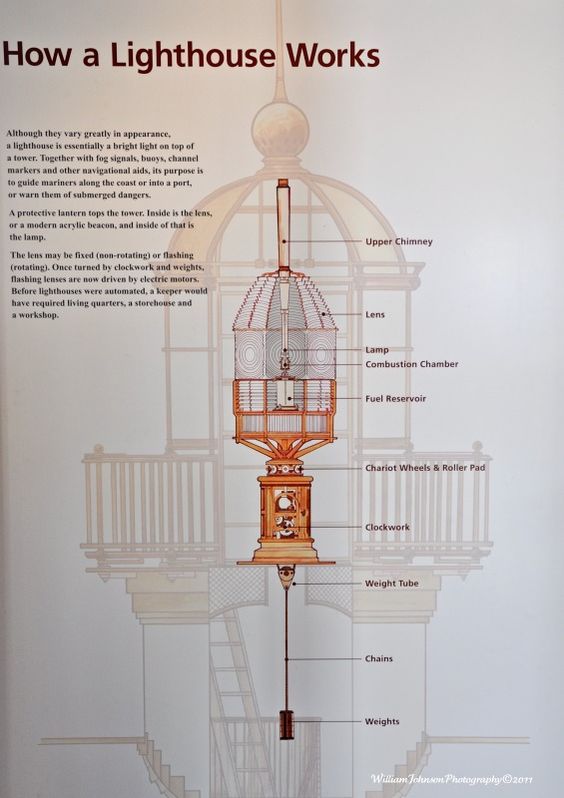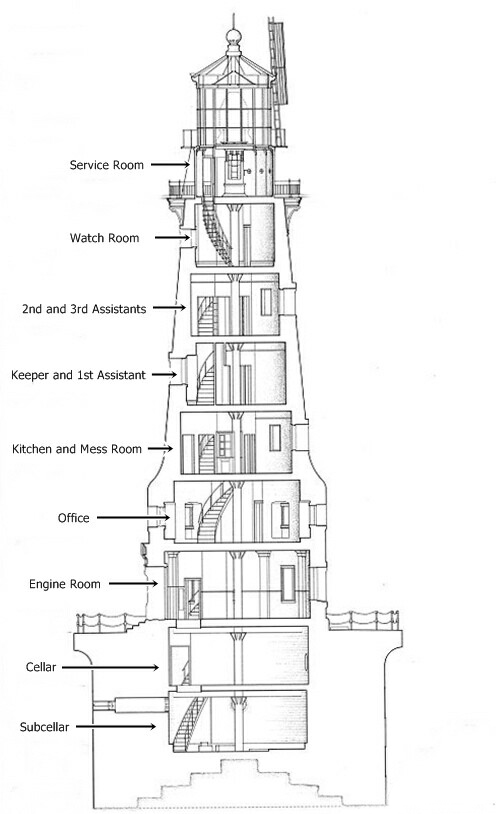Lighting The Way

Winslow Lewis held center stage in the history of lighthouses for a period of forty years in the United States. In 1805, the 35-year-old captain operated ships between Boston, Massaachusetts and Liverpool, England. This enterprise came to a halt when an embargo was established against the English, in 1807. This resulted in Lewis’s venture into experimenting with new modes of beaconing. In 1810, he patented his “reflecting and magnifying lantern” which became known as the Lewis Lens. It was manufactured using a slightly green molded glass that was 9-inches in diameter. The round lens was seated in a copper rim and placed in front of the lamp, thus, both reflecting and magnifying the light beam. By the end of 1812, forty of the forty-nine U.S. lighthouses in existence were converted to the Lewis Lens. The remaining nine lighthouses were converted in 1815, shortly after the the War of 1812 had ended. In 1816, Lewis contracted with the United States to supply oil for all the lighthouses and to provide an annual inspection tour personally to each light station and deliver a report on the condition of each. He lost this contract to competition in 1827, and then directed his attention to building light towers. His first construction was the Frank’s Island Light station at the Northeast Pass of the Mississippi River. In 1819, Benjamin Latrobe, designer of the United States Capitol and recognized father of American architecture, designed the tower. The contract was for $79,000, but because Lewis didn’t have faith in the design, he accepted the contract with a stipulation that he had to be paid regardless, even if the tower toppled during construction. Winston Lewis had publicly stated that the site foundation would not hold the weight of the planned lighthouse as designed by Latrobe. Coincidentally, just 8 days before completion of the tower – the foundation failed. Thus, fully paid, in 1822, Lewis submitted a set of plans of his own and re-erected the fallen tower for just $9,750. After this, Winston Lewis became the principle builder of light towers in the United States numbering eighty in total. Confident of his structures, he designed five sets of plans, each varying only by height. Unfortunately, Lewis’s monopoly hold prevented the introduction of the French Fresnel Lens which was a major innovation in Europe as early as 1830.
French physicist Augustin-Jean Fresnel (pronounced Fray-nel) revolutionized the light emitting system from lighthouses. The Fresnel lens combined the characteristics of the two former techniques, causing a central reflecting bull’s eye to emerge as a single concentrated beam shaft for light that traveled in one direction. His technique involved a series of concentric prismatic rings and refracting prisms. It was so well designed, that the Fresnel lens essentially has remained unchanged to today. When the Fresnel lens first came into operation the large heavy lenses rested on wheels or on ball bearings in a track that was positioned at the base of the lenses. The light beam moved slowly as the turning lens caused the viewer of the light to see a flash with periods of dark between. The first lens apparatus was operated by a clockwork mechanism much like a grandfather clock with chains, pulleys, and weights.
Optics
With the development of the steady illumination of the Argand lamp and the application of optical lenses to increase and focus light, intensity became a practical possibility. William Hutchinson developed the first practical optical system in 1763, known as a catoptric system. He constructed parabolic reflectors by attaching small pieces of reflective material to a cast that had been moulded into an approximate parabola. This rudimentary system effectively focused the emitted light into a concentrated beam, thereby greatly increasing the light's visibility. His system was installed in the newly-built Leasowe Lighthouse and was later copied elsewhere. The ability to focus the light led to the first revolving lighthouse beams, where the light would appear to the mariners as a series of intermittent flashes. It also became possible to transmit complex signals using the light flashes. The idea of creating a thinner, lighter lens by making it with separate sections mounted in a frame is attributed to Georges-Louis Leclerc, Comte de Buffon. The marquis de Condorcet (1743–1794) proposed grinding such a lens from a single thin piece of glass. However, it was the French physicist and engineer Augustin-Jean Fresnel who is credited with the development of the multi-part Fresnel lens for use in lighthouses. His design allowed for the construction of lenses of large aperture and short focal length, without the mass and volume of material that would be required by a lens of conventional design. A Fresnel lens can be made much thinner than a comparable conventional lens, in some cases taking the form of a flat sheet. A Fresnel lens can also capture more oblique light from a light source, thus allowing the light from a lighthouse equipped with one, to be visible over much greater distances. The first Fresnel lens was used in 1823 in the Cordouan lighthouse at the mouth of the Gironde estuary; its light could be seen from more than 20 miles(32 km) out. Scottish physicist Sir David Brewster is credited with convincing the British authorities to adopt these lenses in their lighthouses. Fresnel’s invention increased the luminosity of the lighthouse lamp by a factor of 4 and his system is still in use in many lighthouses today.
Development and Advancements
The advent of electrification and automatic lamp changers began to make lighthouse keepers obsolete. For many years, lighthouses still had keepers, partly because lighthouse keepers could serve as a rescue service if necessary. Improvements in maritime navigation and safety such as the Global Positioning System (GPS) have led to the phasing out of non-automated lighthouses across the world. In Canada, this trend has been stopped and there are still 50 staffed light stations operating throughout that country. Remaining modern lighthouses are more functional and less picturesque. They use solar-charged batteries and have a single stationary flashing light sitting on a steel skeleton tower. In a lighthouse, the source of light is called the "lamp" (whether electric or fueled by oil) and the concentration of the light is by the "lens" or "optic". Originally lit by open fires and later candles, the Argand hollow wick lamp and parabolic reflector were introduced in the late 18th century. Whale oil was also used with wicks as the source of light. Kerosene became popular in the 1870s and electricity and carbide (acetylene gas) began replacing kerosene around the turn of the 20th century. Carbide was promoted by the Dalén light which automatically lit the lamp at nightfall and extinguished it at dawn. During the Cold-War, many remote Soviet lighthouses were powered by Radioisotope thermoelectric generators (RTGs). These had the advantage of providing power day or night and did not need refuelling or maintenance. However, after the breakdown of the Soviet Union, there are no official records of the locations or condition of all of these lighthouses. As time passes, their condition is degrading; many have fallen victim to vandalism and scrap metal thieves, who may not be aware of the dangerous radioactive contents. Before modern strobe lights, lenses were used to concentrate the light from a continuous source. Vertical light rays of the lamp are redirected into a horizontal plane, and horizontally the light is focused into one or perhaps a few directions at a time, with the light beam swept around. As a result, in addition to seeing the side of the light beam, the light is directly visible from greater distances but and with a unique identifying light characteristic. This concentration of light is accomplished with a rotating lens assembly. In early lighthouses, the light source was a kerosene lamp or, earlier, an animal or vegetable oil Argand lamp. The lenses rotated by a weight-driven clockwork assembly wound by lighthouse keepers, sometimes as often as every two hours. The lens assembly sometimes floated in liquid mercury to reduce friction. In more modern lighthouses, electric lights and motors were used, generally powered by diesel electric generators. These also supplied electricity for the lighthouse keepers. Efficiently concentrating the light from a large omnidirectional light source requires a very large diameter lens. This would require a very thick and heavy lens if a conventional lens were used. The Fresnel lens focused 85% of a lamp's light versus the 20% focused with the parabolic reflectors of the time. Its design enabled construction of lenses of large size and short focal length without the weight and volume of material in conventional lens designs. Fresnel lighthouse lenses are ranked by order, a measure of refracting power, with a first order lens being the largest, most powerful and expensive; and a sixth order lens the smallest. The order is based on the focal length of the lens. A first order lens has the longest focal length, with the sixth being the shortest. Coastal lighthouses generally use first, second, or third order lenses, while harbor lights and beacons use fourth, fifth, or sixth order lenses. Some lighthouses, such as those at Cape Race, Newfoundland, and Makapuu Point, Hawaii, used a more powerful hyperradiant Fresnel lens manufactured by the firm of Chance Brothers. In recent times, many Fresnel lenses have been replaced by rotating aerobeacons which require less maintenance. In modern automated lighthouses, this system of rotating lenses is often replaced by a high intensity light that emits brief omnidirectional flashes (concentrating the light in time rather than direction). These lights are similar to obstruction lights used to warn aircraft of tall structures. Recent innovations are "Vega Lights" and initial experiments with light-emitting diode (LED) panels. In any of these designs an observer, rather than seeing a continuous weak light, sees a brighter light during short time intervals. These instants of bright light are arranged to create a light characteristic or pattern specific to a lighthouse. For example, the Scheveningen Lighthouse flashes are alternately 2.5 and 7.5 seconds. Some lights have sectors of a particular color (usually formed by colored panes in the lantern) to distinguish safe water areas from dangerous shoals. Modern lighthouses often have unique reflectors or Racon transponders so the radar signature of the light is also unique. For effectiveness, the lamp must be high enough to be seen before the danger is reached by a mariner. The minimum height is calculated by a trigonometric formula, d=1.17\sqrt {H} where H is the height above water in feet, and d is the distance to the horizon in nautical miles.
Structure, Architecture and Construction
Where dangerous shoals are located far off a flat sandy beach, the prototypical tall masonry coastal lighthouse is constructed to assist the navigator making a landfall after an ocean crossing. Often these are cylindrical to reduce the effect of wind on a tall structure, such as Cape May Light. Smaller versions of this design are often used as harbor lights to mark the entrance into a harbor, such as New London Harbor Light. Where a tall cliff exists, a smaller structure may be placed on top such as at Horton Point Light. Sometimes, such a location can be too high, for example along the west coast of the United States, where frequent low clouds can obscure the light. In these cases, lighthouses are placed below clifftop to ensure that they can still be seen at the surface during periods of fog or low clouds, as at Point Reyes Lighthouse. Another victim of fog was the Old Point Loma lighthouse, which was replaced in 1891 with a lower lighthouse, New Point Loma lighthouse. As technology advanced, prefabricated skeletal iron or steel structures tended to be used for lighthouses constructed in the 20th century. These often have a narrow cylindrical core surrounded by an open lattice work bracing, such as Finns Point Range Light. Sometimes a lighthouse needs to be constructed in the water itself. Wave-washed lighthouses are masonry structures constructed to withstand water impact, such as Eddystone Lighthouse in Britain and the St. George Reef Light off California. In shallower bays, Screw-pile lighthouse ironwork structures are screwed into the seabed and a low wooden structure is placed above the open framework, such as Thomas Point Shoal Lighthouse. As screw piles can be disrupted by ice, steel caisson type lighthouses such as Orient Point Light are used in cold climates. Orient Long Beach Bar Light (Bug Light) is a blend of a screw pile light that was converted to a caisson light because of the threat of ice damage. In waters too deep for a conventional structure, a lightship might be used instead of a lighthouse, such as the former lightship Columbia. Most of these have now been replaced by fixed light platforms, such as Ambrose Light similar to those used for offshore oil exploration.
Other Considerations
While lighthouse buildings differ depending on the location and purpose, they tend to have several common components:
- A light station comprises the lighthouse tower and all outbuildings, such as the keeper's living quarters, fuel house, boathouse and fog-signaling building. The Lighthouse itself consists of a tower structure supporting the lantern room where the light operates.
- The lantern room is the glassed-in housing at the top of a lighthouse tower containing the lamp and lens. Its glass storm panes are supported by metal Astragal bars running vertically or diagonally. At the top of the lantern room is a stormproof ventilator designed to remove the smoke of the lamps and the heat that builds in the glass enclosure. A lightning rod and grounding system connected to the metal cupola roof provides a safe conduit for any lightning strikes.
- Immediately beneath the lantern room is usually a Watch Room or Service Room where fuel and other supplies are kept and where the keeper prepares the lanterns for the night and often stands watch. The clockwork mechanisms (for rotating the lenses) were also located there. On a lighthouse tower, an open platform called the gallery is often located outside the Watch Room (Main Gallery) or Lantern Room (Lantern Gallery). This is mainly used for cleaning the outside of the windows of the Lantern Room.
- Lighthouses near each other that are similar in shape are often painted in a unique pattern so they can easily be recognized during daylight. This marking is known as a "daymark." The black and white barber pole spiral pattern of Cape Hatteras Lighthouse is one example. Race Rocks Light in western Canada is painted in horizontal black and white bands to stand out against the horizon.
- Aligning two fixed points on land provides a navigator with a line of position called a range in the U.S. and a transit in Great Britain. Ranges can be used to precisely align a vessel within a narrow channel such as in a river. Landmarks illuminated within a range with a set of fixed lighthouses make nighttime navigation possible. Such paired lighthouses are called range lights in the U.S. and leading lights in the United Kingdom. The closer light is referred to as the beacon or front range; the one furthest away is called the rear range. The rear range light is almost always taller than the front. When the vessel is on the correct course, the two lights line up vertically. But, when the observer is out of position, the difference in alignment indicates the proper direction of travel and a course correction can be made and engaged.
Read more about the history,development and preservation of Lighthouses:
United States Lighthouse Society
Encyclopedia Brittanica's Complete Guide on Lighthouses
How Lighthouses Changed American History
Tons of books on everything about Lighthouses from Amazon.com




